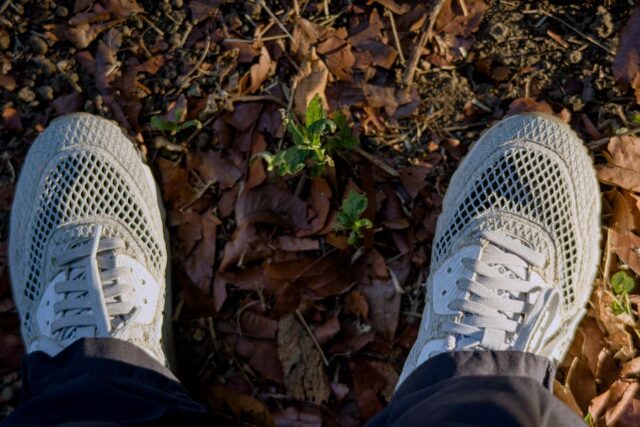Running on pavement can be hard on the knees and other joints. Each step can generate 3x of your body weight in force, and repeated impact can cause discomfort and injuries over time.
Adding trail runs to your routine can help your body adjust to the softer surface. Using the right shoes for your terrain can make the transition seamless.
Stability
The stability of your shoe comes from the structure in the midsole – the thick foam that absorbs impacts when you hit the ground. How firm the foam is and how high its stack height is (also called the “stack height”) are factors you can adjust to tailor your shoe for your running style and needs.
For example, if you’re an over-pronator, look for shoes with heavy cushioning and plenty of structure. Its latest iteration keeps its renowned workhorse status, blending an old-school with the sock liner and a more flexible dual-layered mesh upper. The result is a shoe that feels stiff for easy runs but can carry you through long, slow miles niggle-free. Additionally, brands like Hoka One One also emphasize features catering to specific pronation needs, providing a diverse range of options for runners seeking stability and support in their footwear.
Other stability-related elements include the geometry of an outsole’s lugs and the rubber compound used. For example, softer summer tires use a soft rubber for gripping dry pavement, while knobby tires use a more rigid compound for off-road surfaces with loose terrain.
Comfort
Every runner’s comfort level is different. Some may love the feel of a soft surface underfoot, while others prefer a firmer shoe that helps control pronation. The best surface to run on depends on the runner’s environment, access to other terrains, and goals.
If you’re looking for a road running shoe that can handle a bit of trail, look no further. It features a zero-mm heel-to-toe offset, a wide toebox extension, ras-like gaiter attachment points, and a unique rock shield that allows it to stand up to trails.
Asphalt isn’t the softest surface to run on, but it’s much easier on your feet than concrete. Concrete is primarily made of cement (crushed rock) found on 95 percent of pavements and 5 percent of roads. This hard surface stresses your legs and joints, so it’s important to alternate your surfaces to avoid overuse injuries. You can also opt for a softer pavement like an urban paving stone or sand.
Breathability
In running, “breathability” refers to how well moisture passes through a shoe’s upper fabric. Since road shoes aren’t frequently scraped by rocks and roots like trail shoes, their uppers can be more lightweight and breathable.
Testers found the breathable upper of this shoe soft and stretchy, offering a snug lockdown without feeling tight. They also appreciated the shoe’s ability to breathe, keeping their feet cool during long runs and speed workouts.
The shoe’s specialized rubber and dense colony of lugs are ideal for multi-surface, all-season traction. While the lugs are not as aggressive as those in many trail shoes, they still offer confident traction when running on slippery roads or snow and ice-covered trails. If you prefer a moderate heel-to-toe drop, this shoe’s traditional feel might be right up your alley. This cushioned shoe initially feels stiff out of the box, but it breaks in quickly and offers a comfortable ride for everyday road running or midwinter speed workouts. The shoe’s 3/4 carbon plate and a big wedge of Pwrrun foam deliver a snappy transition, making it suitable for fast intervals and hill workouts.
Weight
You can encounter various surface conditions and terrain when running on a trail, from hard-packed dirt to muddy leaves to sand. Regardless of the surface, you want a shoe that can take on your miles without wearing out prematurely.
An excellent option for a runner transitioning from pavement to trail is a running shoe, not specifically a trail design. It uses features commonly found in road running shoes, like airy mesh and lightweight cushioning, yet has the durability of a shoe built for off-road trails.
Another good option for a crossover shoe offering an ideal mix of road and trail-running features for experienced runners. Its lugs have an ample bite for hard surfaces, and its durable construction and quick-lace system can withstand long training blocks. It also has some eye-catching design elements that help it stand out, like a stretchy engineered mesh upper and an overlay pattern that helps resist ripping and tearing.
Traction
Traction on the road is less of an issue for runners, but when you venture out on a rocky, sandy, or uneven trail, traction is essential to keep your footing. Running shoes designed for trails typically have broader lugs and more space between them to shed mud, gravel, and other debris. They also offer multidirectional traction for better stability and to prevent slips on uneven surfaces. For example, the dense colony of specialized lugs offers a confidence-inspiring grip on multiple surfaces and terrains.
Consider a traction device if you frequently run on icy sidewalks and roads or plan to hit the trail in snowy conditions. These traction devices, made of 10 spikes on raised plastic, provide excellent grip when wet or icy ground, though they may work better on bare dirt. These traction devices are easy to get on and off, compact enough to fit in your pocket or bag and perform just as well on ice as on soft or hard-packed snow.














